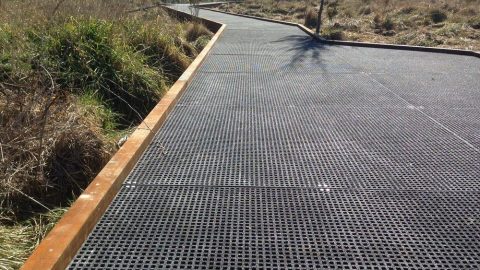Fibre-reinforced polymer (FRP), also Fibre-reinforced plastic, is a composite material made of a polymer matrix reinforced with fibres. The fibres are usually glass, carbon, or aramid, although other fibres such as paper or wood or asbestos have been sometimes used. The polymer is usually an epoxy, vinylester or polyester thermosetting plastic, and phenol formaldehyde resins are still in use. FRPs are commonly used in the aerospace, automotive, marine, and construction industries.
Composite materials are engineered or naturally occurring materials made from two or more constituent materials with significantly different physical or chemical properties which remain separate and distinct within the finished structure. Most composites have strong, stiff fibres in a matrix which is weaker and less stiff. The objective is usually to make a component which is strong and stiff, often with a low density. Commercial material commonly has glass or carbon fibres in matrices based on thermosetting polymers, such as epoxy or polyester resins.
Due to many outstanding advantages, FRP reinforcement is gradually replacing the position of reinforcement in the field of reinforced concrete bearing:
- The tensile strength of FRP reinforcement is 3 times higher than that of reinforcement, so that the area of reinforced reinforcement can be reduced by a third.
- The density is 5 times lower than reinforcement, so products using FRP reinforcement will have a lighter load.
- There is no electromagnetism so it can be used in specific constructions such as photo studio, broadcast station, production room of electronic components, …
- Composite composite products are highly resistant to corrosion, so the concrete protection layer can be reduced by 15-20 mm in thickness.
- Reinforced FRP has high fatigue strength, can withstand cyclic loads with high impact amplitude.
- Easier to transport because with diameter smaller than 12mm, the polymer core can be fully rolled up for efficient and economical transport.
- With light weight and easy to cut, FRP reinforcement can be easily transported, unloaded, constructed and installed for construction.
- Having good alkali resistance, the product is made of polymer reinforcement that is suitable for marine constructions, breakwaters, wharves to avoid corrosion.
- Because of the thermal expansion coefficient similar to concrete, when changing temperatures, the product does not appear cracks.
- With high durability, fully reinforced polymer concrete products have a longer lifespan than the same products using reinforcement to 2-3 times.
- With thermal conductivity up to 100 times lower than steel, using polymer reinforced concrete helps reduce heat loss to the environment.
- Non-toxic, so the product is completely safe for human and surroundings.
With such advantages, polymer core is gradually being produced and used in our country. Specifically, Polymer Polymer Vietnam Joint Stock Company has received the production technology and proceeded to market products such as reinforced fiber aggregates or composite mesh. Products promise to be applied more and more in the works.
Source: Intech Open
